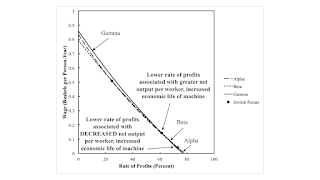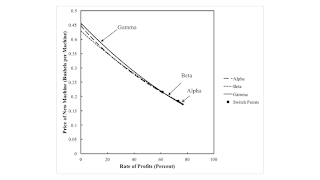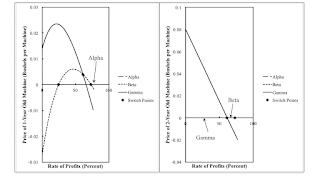Figure 1: The Wage-Rate of Profits Frontier1.0 Introduction This post completes a demonstration that the economic life of a machine is independent of the capital-intensity of a technique. I here fill in the upper right of a two-by-two table. I have previously filled in the upper-left and lower right entries. And I also have an example for the lower left. 2.0 Technology Tables 1 and 2 present coefficients of production for processes which can be combined to produce a new output of corn. The example has the structure of one from Salvatore Baldone. Corn is assumed to be the sole consumer good and the numeraire. In the first process, labor works with corn input to produce a machine with a physical life of three years. Labor works with seed corn and machines of the specified age, in each
Topics:
Robert Vienneau considers the following as important: Austrian School Of Economics, Example in Mathematical Economics, Sraffa Effects
This could be interesting, too:
Robert Vienneau writes Austrian Capital Theory And Triple-Switching In The Corn-Tractor Model
Robert Vienneau writes Double Fluke Cases For Triple-Switching In The Corn-Tractor Model
Robert Vienneau writes The Emergence of Triple Switching and the Rarity of Reswitching Explained
Robert Vienneau writes Recap For A Triple -Switching Example
| Figure 1: The Wage-Rate of Profits Frontier |
This post completes a demonstration that the economic life of a machine is independent of the capital-intensity of a technique. I here fill in the upper right of a two-by-two table. I have previously filled in the upper-left and lower right entries. And I also have an example for the lower left.
2.0 TechnologyTables 1 and 2 present coefficients of production for processes which can be combined to produce a new output of corn. The example has the structure of one from Salvatore Baldone. Corn is assumed to be the sole consumer good and the numeraire. In the first process, labor works with corn input to produce a machine with a physical life of three years. Labor works with seed corn and machines of the specified age, in each of the remaining processes, to produce a unit of corn and machines a year older. The machine is discarded after being operated in the last process.
| Input | Process | |||
| (I) | (II) | (III) | (IV) | |
| Labor | 21/50 | 39/200 | 117/200 | 39/100 |
| Corn | 12/125 | 39/100 | 141/250 | 117/200 |
| New Machines | 0 | 1 | 0 | 0 |
| One-Year Old Machines | 0 | 0 | 1 | 0 |
| Two-Year Old Machines | 0 | 0 | 0 | 1 |
| Output | Process | |||
| (I) | (II) | (III) | (IV) | |
| Corn | 0 | 1 | 1 | 1 |
| New Machines | 1 | 0 | 0 | 0 |
| One-Year Old Machines | 0 | 1 | 0 | 0 |
| Two-Year Old Machines | 0 | 0 | 1 | 0 |
Three techniques exist for producing a net output for corn. The Alpha, Beta, and Gamma technique differ in the economic life of the machine. In Alpha, the economic life of the machine continues to be one-year, while it remains its full physical life of three years in Gamma. Figure 1, at the top of this post, displays the wage curves for the three techniques. Gamma is cost-minimizing at a low rate of profits. Beta is cost-minimizing at an intermediate rate of profits, and Alpha is cost-minimizing at a high rate of profits. The wage curves for the Alpha and Beta techniques intersect at a low rate of profits within the frontier.
Perhaps this example is clarified by looking at prices. As shown in Figure 2, the price of a new machine is positive for the whole range of feasible rate of profits in the system of equations for each technique. Figure 3 graphs the prices of old machine of each age as a function of the rate of profits. Suppose the machine is operated for its physical life of three years, as under Gamma. The price of a two-year old machine is positive for rates of profits up to a switch point with Beta, at approximately 61 percent. The price of a one-year old machine is positive even for rates of profits slightly higher. Thus, the analysis of the choice of production based on prices confirms that Gamma is cost-minimizing at low rates of profits.
| Figure 2: The Price Of A One-Year Old Machine |
| Figure 2: The Prices Of Old Machines |
The price of a two-year old machine under Beta is zero. The price of a one-year old machine, when it is operated for two years, is positive between a rate of profits of approximately 24 and of 73 percent. That is, in a range of high rates of profits where Gamma is no longer cost-minimizing, Beta is cost-minimizing in the indicated range. Finally, Alpha is cost-minimizing in the highest range of profits, when the prices of one-year old and two-year old machines is negative under both Beta and Gamma.
If the physical life of a machine were two years, this example would be one of a reswitching. Around the switch point between Alpha and Beta at approximately 73 percent, a lower rate of profits is associated with a decreased value of capital per worker and an increased net output of corn per worker. On the other hand, around this switch point, a lower rate of profits is associated with an increased economic life of the machine.
4.0 ConclusionThis example fills in the upper right of this table. Table 1. The economic life of a machine is independent of the capital intensity of the techniques in which the machine is operated.
 Heterodox
Heterodox



